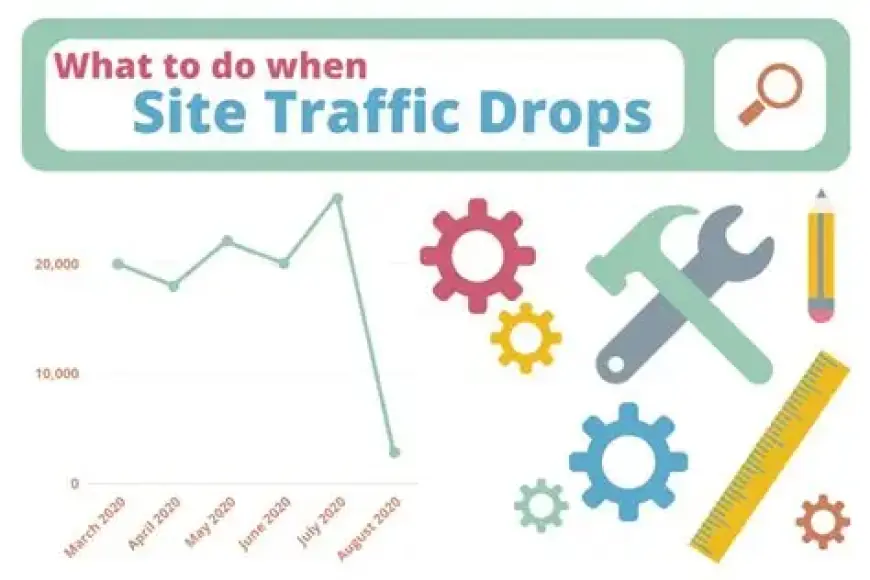How Do You Handle a Drop in Website Traffic?
Identify traffic drop causes through data analysis, fix technical issues, update SEO/content, monitor competitors, adjust ads, and stay consistent.

A sudden drop in website traffic can be alarming, especially for businesses that rely heavily on their online presence for sales and lead generation. However, it's important to approach the situation calmly and methodically to identify the root cause and take corrective actions. Traffic fluctuations are a normal part of the digital landscape, but consistent and significant drops often require a deeper dive to understand what is going wrong. Here’s how to handle a drop in website traffic and get back on track.
1. Analyze the Data: Pinpoint the Problem
Before you take any action, it's essential to gather data and analyze what is causing the drop. Tools like Google Analytics, SEMrush, or Ahrefs can help you identify when the traffic decline began and which pages were most affected. Look at the following metrics:
-
Organic traffic: Has there been a decrease in search engine traffic? This might indicate an issue with SEO or an algorithm change from Google.
-
Paid traffic: If you're running PPC campaigns, a sudden drop in paid traffic could signal a budget issue, ad fatigue, or poor targeting.
-
Referral traffic: If you’ve lost backlinks or referral traffic from other websites, your overall traffic could decrease.
-
Direct traffic: A drop in direct traffic may indicate that brand awareness or repeat visitors has diminished.
By understanding which channels are underperforming, you can start to focus on specific areas of your digital marketing strategy that need attention.
2. Check for Technical Issues
One of the most common causes of a traffic drop is technical issues on the website. Even small errors can significantly affect your search rankings and user experience. Some technical problems to investigate include:
-
Site speed: Slow loading times can lead to higher bounce rates and lower rankings in search engines. Use tools like Google PageSpeed Insights or GTmetrix to test your site’s performance.
-
Mobile responsiveness: Ensure that your website is optimized for mobile devices, as Google gives preference to mobile-friendly websites in search results.
-
Broken links or 404 errors: Use tools like Screaming Frog or Google Search Console to identify any broken links or pages that are returning 404 errors. These can disrupt both user experience and SEO performance.
-
Indexing issues: Check if your pages are still indexed by search engines. Sometimes, a technical error can result in pages being de-indexed or blocked from crawling by search engines.
Fixing these technical issues quickly can often restore lost traffic.
3. Review Algorithm Updates
Search engine algorithms, particularly those of Google, are constantly evolving. Google frequently rolls out updates that can impact how your website ranks for certain keywords. If your traffic drop coincides with a Google algorithm update, it’s likely that your website’s rankings have been affected.
To handle this, you should:
-
Stay informed about algorithm changes: Follow SEO news sources like Moz, Search Engine Journal, or Google’s own blog to keep up with updates and how they affect ranking factors.
-
Analyze your rankings: Use tools like Google Search Console, SEMrush, or Ahrefs to monitor shifts in keyword rankings. A drop in rankings for key search terms may explain a drop in organic traffic.
-
Adjust your SEO strategy: If an algorithm update impacts your rankings, it might be time to re-evaluate your SEO strategy. Focus on creating high-quality content, improving user experience, and gaining authoritative backlinks.
While algorithm updates are inevitable, adapting to them is key to regaining lost traffic.
4. Reassess Content Strategy
Another reason for a drop in website traffic could be a lack of fresh or relevant content. If your content is outdated or no longer resonates with your audience, it may no longer perform well in search engine results.
Here’s how to address this:
-
Update existing content: Refresh old blog posts, product pages, and landing pages to ensure they’re up-to-date with current information and trends. Google values fresh content.
-
Expand your content: If your content isn’t comprehensive enough or fails to meet user intent, consider expanding it. For example, turning short blog posts into detailed guides or adding more relevant keywords.
-
Create new content: Regularly publishing new, high-quality content can help you attract more visitors and improve your site’s authority. Focus on topics that are trending within your industry or solve problems your audience is facing.
Content is king in SEO. Consistently providing valuable, high-quality content can help restore traffic and even boost it in the long run.
5. Investigate Competitor Changes
It’s possible that your competitors have made changes to their websites or digital marketing strategies, causing them to outperform you. This could lead to a drop in your traffic if they’re attracting more visitors than you.
To handle this, you should:
-
Analyze competitor websites: Use tools like SEMrush, Ahrefs, or SpyFu to examine your competitors' SEO strategies, paid ads, and backlinks. Are they targeting different keywords? Have they improved their content?
-
Find content gaps: Identify areas where your competitors might be providing better content or a more comprehensive offering. You can then capitalize on these gaps by improving your own content or expanding your product/service offerings.
Staying ahead of your competition requires regular monitoring and adjustments to your digital marketing strategy.
6. Evaluate Your Paid Advertising Campaigns
If you’re relying on paid advertising for traffic, such as PPC, you’ll want to review your campaigns to identify any issues. Look at:
-
Ad fatigue: Are your ads becoming stale? If users see the same ad repeatedly without engaging, this can result in a decrease in performance.
-
Budget issues: Have your bids changed, or has your budget been reduced? This can lead to a drop in ad impressions and, consequently, traffic.
-
Targeting errors: Check if your targeting is still relevant. If your ads are reaching the wrong audience, you may not be generating high-quality traffic.
Regularly optimizing your PPC campaigns can help prevent these issues and maintain consistent traffic.
7. Focus on Link Building and Backlinks
Losing backlinks or not acquiring new ones can cause a drop in organic traffic, as Google views backlinks as a vote of confidence. If other authoritative sites no longer link to your content, your rankings and traffic may suffer.
To fix this, you can:
-
Rebuild lost backlinks: Use tools like Ahrefs to identify lost backlinks and reach out to those websites to request the links be restored.
-
Build new backlinks: Focus on outreach and guest blogging to build new high-quality backlinks. Participating in industry forums or collaborating with influencers can also help.
-
Avoid toxic backlinks: If you have any low-quality or spammy backlinks, disavowing them through Google Search Console can prevent them from negatively affecting your rankings.
Link building is an ongoing process, and high-quality backlinks are crucial for improving your website’s authority and boosting traffic.
8. Be Patient and Stay Consistent
Recovering from a drop in traffic doesn’t happen overnight. Whether you’re working on fixing technical issues, updating content, or rebuilding backlinks, it’s essential to remain patient and stay consistent in your efforts. Track progress using Google Analytics and other SEO tools, and remember that it can take weeks or even months to see significant improvements in traffic.
Conclusion
A drop in website traffic doesn’t have to spell disaster. By carefully analyzing the data, identifying technical issues, adjusting your SEO strategies, and staying on top of industry trends, you can regain your lost traffic and even grow it. Addressing the situation methodically and maintaining a proactive approach will not only help you recover but can also lead to stronger and more sustainable website performance in the future.
What's Your Reaction?
 Like
0
Like
0
 Dislike
0
Dislike
0
 Love
0
Love
0
 Funny
0
Funny
0
 Angry
0
Angry
0
 Sad
0
Sad
0
 Wow
0
Wow
0



















































